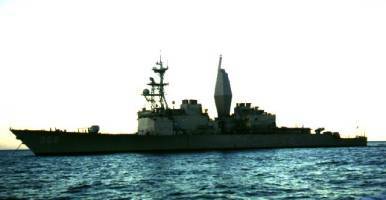This is a description of the mast installed on the USS Arthur Radford, the prototype for the new masts being installed on the San Antonio class LPDs:
The AEM/S System is a 93' high, hexagonal structure, 35' in diameter, enclosing existing radar and providing important signature and other operational benefits. By enclosing major antennas and other sensitive equipment, the AEM/S System protects them from the weather. This reduces maintenance, as well as providing significantly reduced radar signature.
 A traditional "Mast Stepping" Ceremony was held on 17 May at Norfolk Naval Shipyard to commemorate mast installation and to honor the AEM/S System Masters who dedicated more than three years to the project.
A traditional "Mast Stepping" Ceremony was held on 17 May at Norfolk Naval Shipyard to commemorate mast installation and to honor the AEM/S System Masters who dedicated more than three years to the project.
The AEM/S System ATD has developed a revolutionary mast that is affordable, solves problems associated with current masts, enables new technology required for the Navy's next generation of stealthy ships, reduces life-cycle costs, enhances sustainability, and most importantly, enhances war-fighting capabilities. Successful completion of this ATD is a key element in the incorporation of advanced technology into the topside design for the next generation of surface combatants.
The AEM/S System is a high-risk, high-payoff Advanced Technology Demonstration. Benefits and payoffs include:
Enhanced Performance:
The AEM/S System is fabricated with an advanced composite hybrid frequency selective surface (FSS), designed to allow passage of own-ship sensor frequencies while reflecting other frequencies. Improved sensor performance results from reduction of blockage, false targets and sensor downtime, thereby dramatically enhancing the ship's war-fighting capability.
Affordable Low-Cost Manufacturing:
The AEM/S System utilizes unique materials, creative structures and innovative manufacturing techniques, yet the mast can be produced in a shipyard environment.
Affordable Reduced Life-Cycle Costs:
The AEM/S System's enclosed structure protects radar and communication antennas from weather exposure and provides all-weather access for repair, thus greatly reducing the need for repair, maintenance costs, replacement costs and risk of failure.
Enhanced sustainability:
The AEM/S System concept will enable rapid and seamless transition to the next generation of technology. Features such as embedded sensors, planar arrays, integrated antennas, low observable signatures, reduced topside weight -- all contribute to the Navy's objectives for future warships. Accelerated transition of AEM/S System technology to the LPD 17 is already underway, along with evaluation of its applicability to the SC 21 and CV(X).
The upper half of the AEM/S System is designed to allow passage of own-ship sensor frequencies with very low loss while reflecting other frequencies. It is divided into two radome-like compartments; the upper compartment houses the MK 23 TAS antenna, and the lower encloses the SPSAO air search radar antenna.
The whole system is a free-standing, fully integrated composite structure. Structural design requirements for strength and stiffness meet Fleet requirements for vibration, shock and fatigue. Signature and electromagnetic design requirements are based on criteria associated with sensor and antenna performance, electromagnetic interference, lightning protection electromagnetic shielding, electrical bonding and grounding.
After my shipyard installed it, the first thing that we noticed was that it looked as if the ship was giving the world the finger.